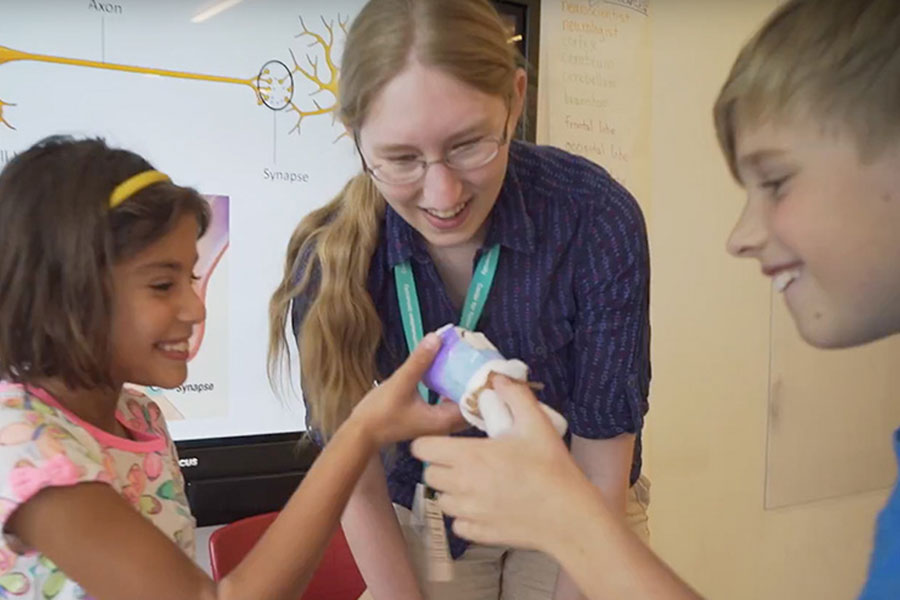Rainy Day Activity: Make A Möbius Strip
- plain paper strips
- scissors
- tape
- pencil
- magic marker
- flat surface to work on
 2. Mark each corner in order. (ABCD)
3. Give the rectangle a half twist.
2. Mark each corner in order. (ABCD)
3. Give the rectangle a half twist.
 4. Using a piece of tape, join the ends so that A is matched with D and B is matched with C.
Investigation: Why does the Möbius Strip have only one side and one edge?
1. Start midway between the edges of a Möbius Strip and draw a line down its center. Continue the line until you return to your starting point. Did you ever cross an edge?
4. Using a piece of tape, join the ends so that A is matched with D and B is matched with C.
Investigation: Why does the Möbius Strip have only one side and one edge?
1. Start midway between the edges of a Möbius Strip and draw a line down its center. Continue the line until you return to your starting point. Did you ever cross an edge?
 2. Next, hold the edge of a Mobius Strip against the tip of a felt-tipped highlighter pen. Color the edge of the Möbius Strip by holding the highlighter still and just rotating the Möbius Strip around. Were you able to color the entire edge?
2. Next, hold the edge of a Mobius Strip against the tip of a felt-tipped highlighter pen. Color the edge of the Möbius Strip by holding the highlighter still and just rotating the Möbius Strip around. Were you able to color the entire edge?
 3. Now, with scissors cut the Mobius Strip along the center line that you drew. Then draw a center line around the resulting band, and cut along it. Did you predict what would happen?
3. Now, with scissors cut the Mobius Strip along the center line that you drew. Then draw a center line around the resulting band, and cut along it. Did you predict what would happen?
 Further Investigation:
Now, think about what would happen if you cut down the center of your Möbius strip. An ordinary paper ring cut in half would give you two separate rings, right?
Further Investigation:
Now, think about what would happen if you cut down the center of your Möbius strip. An ordinary paper ring cut in half would give you two separate rings, right?
 If you cut down the center of a Möbius strip, what happens?
If you cut down the center of a Möbius strip, what happens?
 Additional Resources and Links:
Math is good for you!: The history and theory behind the Möbius strip.
Videos showing the different experiments that can be done with the Möbius strip:
http://www.youtube.com/watch?v=BVsIAa2XNKc&feature=related
http://www.youtube.com/watch?v=IRVOwuHU-M0
http://www.youtube.com/watch?v=6dEnz4tSKNk&feature=related
Have you ever made a Möbius strip before?
Since Fall 2007, Loretta Rice has taught math and science courses for Project EXCITE and Gifted LearningLinks. Some of her past courses include: “It’s a Puzzlement,” “Brain Teasers," and the upcoming “The Geometry of Architecture” in Summer 2012. Register here!
Additional Resources and Links:
Math is good for you!: The history and theory behind the Möbius strip.
Videos showing the different experiments that can be done with the Möbius strip:
http://www.youtube.com/watch?v=BVsIAa2XNKc&feature=related
http://www.youtube.com/watch?v=IRVOwuHU-M0
http://www.youtube.com/watch?v=6dEnz4tSKNk&feature=related
Have you ever made a Möbius strip before?
Since Fall 2007, Loretta Rice has taught math and science courses for Project EXCITE and Gifted LearningLinks. Some of her past courses include: “It’s a Puzzlement,” “Brain Teasers," and the upcoming “The Geometry of Architecture” in Summer 2012. Register here!
